FinDock Bank Feed
FinDock Bank Feed enables automatic importing of bank transactions for reconciliation through Guided Matching. This ensures you have an up-to-date, 360 view of customer payments and eliminates the need for handling bank statement files.
Once you connect your bank to Bank Feed, FinDock checks your account(s) for new account transactions on a daily basis. FinDock automatically imports, processes and matches these transactions through Guided Matching. The out-of-the-box matching rules can be extended through custom rules as needed.
Bank Feed licensing
The Bank Feed license determines how many active account connections you can have at a given time. There is no limit on import volumes as such. FinDock notifies you in the Bank Feed setup if you have reached or exceeded the connection limit. When this occurs, you can either contact FinDock Support to upgrade your license, or disconnect accounts you no longer need.
Please note that if you exceed the licensed limit, e.g. you downgrade your license before disconnecting accounts, both automatic and manual importing is temporarily blocked. The block remains until the number of active connections is reduced to the allowed limit.
Permissions for Bank Feed
The Bank Feed feature requires three permission sets:
- FinDock Core Bank Feed Integration in FinDock Integration User permission set group
- FinDock Core Bank Feed Run in FinDock Payment Operator permission set group
- FinDock Core Bank Feed Setup in FinDock Administrator permission set group
If you are using FinDock permission set groups, Bank Feed users need the FinDock Payment Operator permission set group to be able to use the manual import component (in addition to Guided Matching).
If you want to limit users who can access the Bank Feed feature, directly assign the new permission sets to specific users and use a muting permission set in the FinDock permission set group to remove access for other users.
The automatic import Apex job runs daily through the FinDock Heart Beat which can use the FinDock Integration User permission set group. For details, see the FinDock Core setup instructions.
Setting up Bank Feed
Setting up Bank Feed is simple: first you establish the connection from FinDock, and then you approve the connection from your bank.
To connect an account to Bank Feed:
- Launch the FinDock app and click the FinDock Setup tab.
- In the left-hand menu, click Bank Feed.
- On the Bank Feed setup page, click Add account to set up a new connection.
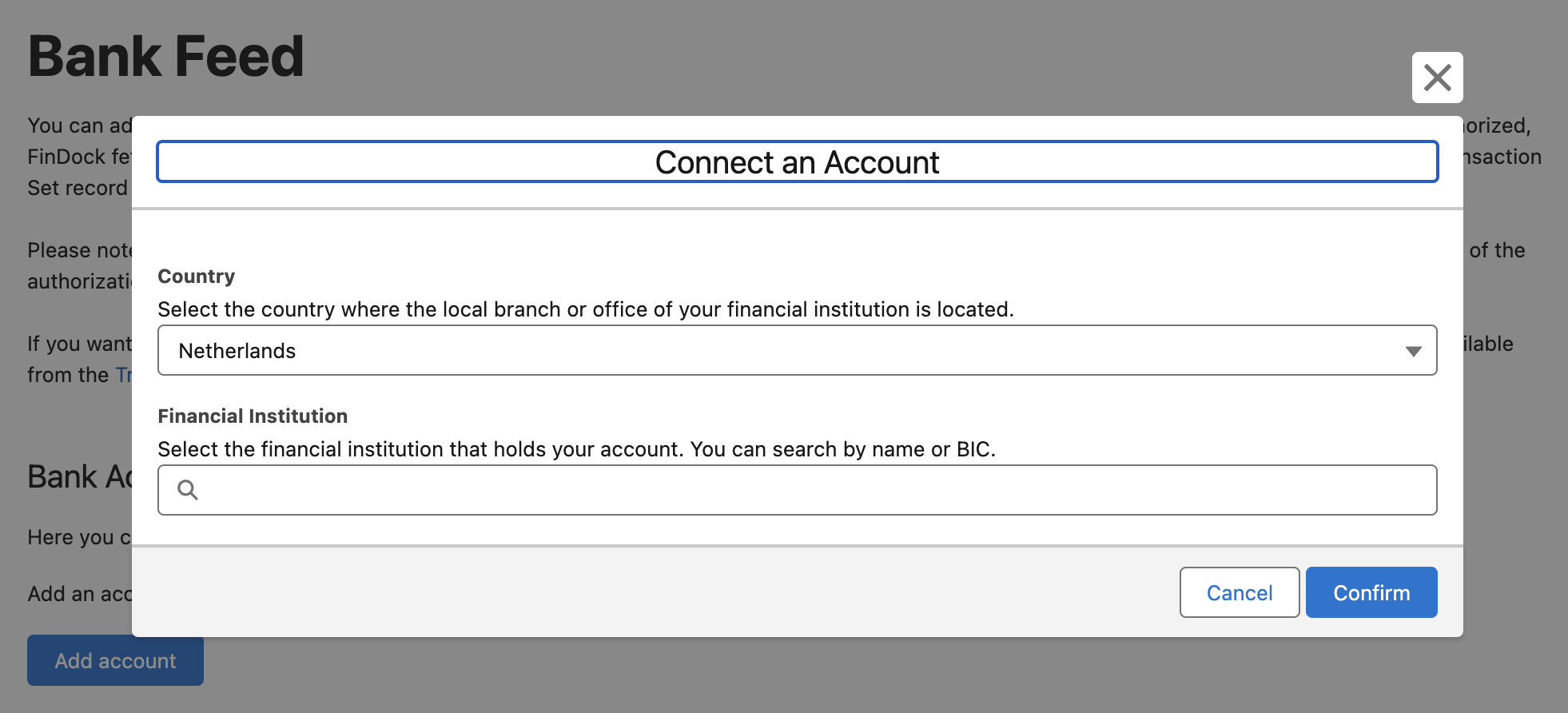
- From the drop-down lists, first select the country of your bank to narrow the list of bank branches.
- Select your bank branch from the drop-down list of banks. You can use the BIC of your bank to quickly find your bank.
- Click Confirm and follow the instructions in the connection flow to authorize the connection.
- After connecting, go to your bank’s account management portal to approve the connection.
Once the connection is authorized, switch on the Automatic Import toggle.
- From the Bank Feed setup, click the Edit button next to the account.
- Toggle on Automatic Import and click Save.
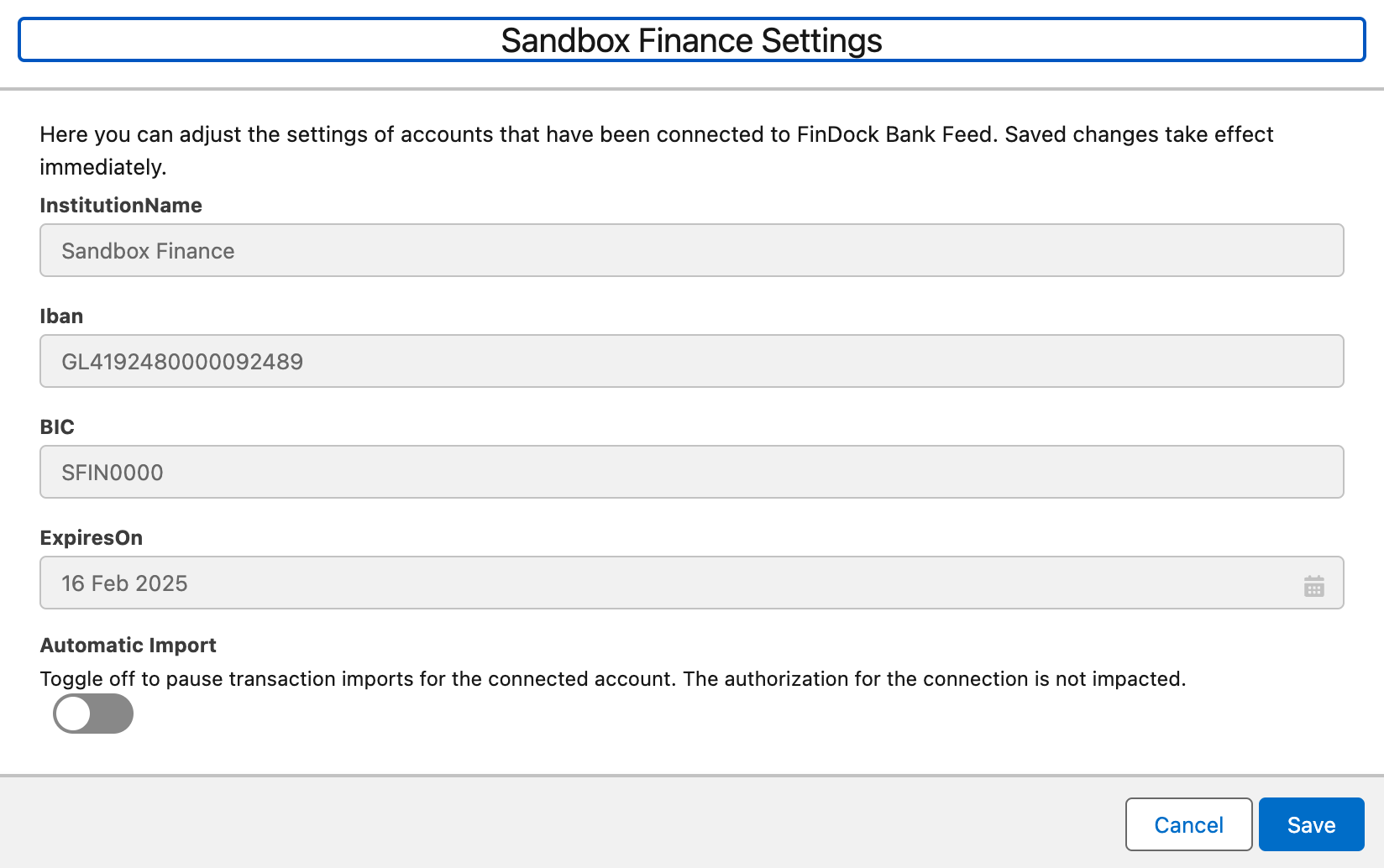
FinDock then starts to automatically import account transactions from the day of the authorization forward.
Bank accounts for payment collection
When you add a new account for Bank Feed, FinDock automatically checks if the bank account number is also used as a merchant account for payment collection. If a merchant account (target) is found, the Bank Feed account settings page a summary of the payment processing setup(s) with links to the related payment processor.
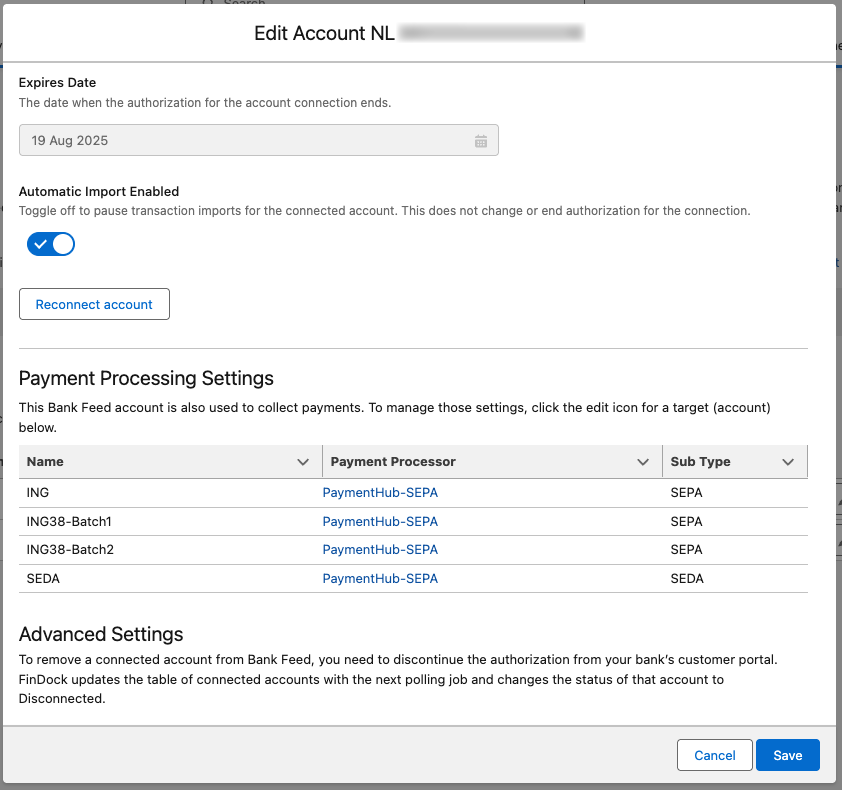
From the payment processor settings, if the bank account number is also used for Bank Feed, a cross-link is provided to Bank Feed.
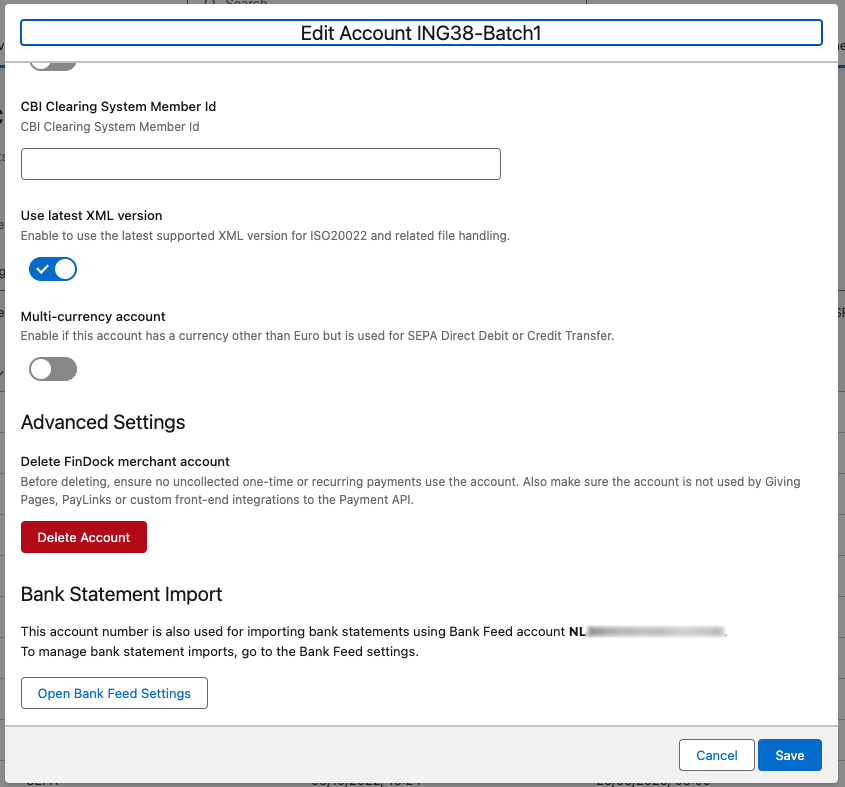
Bank Feed authorization
When you authorize FinDock Bank Feed to connect to your bank account, the authorization key is stored in the specific Salesforce org where the connection was setup. This authorization grants FinDock the right to request and receive general account information like IBAN and holder name, balance information, and transaction details. The authorization does not allow FinDock to change information or, for example, initiate actions on the behalf of the owner of the connected bank account.
Please also note that you can add further restrictions through the granular Salesforce permissions FinDock provides for Bank Feed. This allows you to grant access to specific users for specific purpose, for example, to limit who can trigger a manual import of transaction data.
Authorization validity period
The authorization expires after a fixed period depending on the individual bank. If the authorization request is made from a sandbox org, FinDock requests access for 30 days. In production orgs, the initial request uses a 180-day validity period. Should that fail because the bank doesn't support that many days, FinDock automatically retries the request with a 90-day validity period. You can check from the Bank Feed setup table of connected accounts to see when an authorization expires.
During the authorization period, you can turn off automatic import at any time. You can also remove FinDock Bank Feed access to an account at any time by cancelling the authorization from your banking environment.
Notifications about authorization status
FinDock notifies you of two authorization states: expiring soon and expired. When an account is expiring soon, a warning callout about the need to reauthorize soon is displayed on all FinDock Setup pages. If an account authorization expires, the callout is an error indicating transaction importing has stopped until the account connection is reauthorized.
In addition, we have created a Flow template, Bank Feed Account Expiry Reminder Flow, which you can use to trigger emails to your Bank Feed account managers. For details, see FinDock Labs.
Reauthorizing a connected account
On the Bank Feed setup page, you can check the status and expiration date of each connected account. In the Status column of the table of connected accounts, FinDock indicates if an account authorization is about to expire or has already expired (and was disconnected).
To reauthorize an account:
- Click on the edit icon next to the account.

- Click Reconnect account.
- Follow the guidance in the reauthorization flow.
Please note that any account number can be added in the reauthorization flow. However, FinDock will only complete reauthorization of accounts that had already been connected to Bank Feed.
Disconnecting a bank account
Currently you cannot disconnect a bank account through FinDock. If you need to disconnect a bank account that is currently connected and authorized, you can do so through your bank.
Each bank has its own online bank service or app, so details vary, but the main action is the same: from the list of applications authorized to access your account, remove the “GoCardLess SAS” authorization.
After you have removed authorization, the next time FinDock Bank Feed tries to access the account, the authorization will be automatically disabled in Salesforce as well.
Manual Bank Feed Import component
In addition to the automated import capabilities, FinDock provides a Lightning Web Component (LWC) for defining and running a manual import of transactions over a given time period.
We recommend adding the custom Manual Bank Feed Import component to the list view of Transaction Set.
- Go to Salesforce Setup.
- In the Object Manager, find and open the Transaction Set object.
- In the left-hand menu, click List View Button Layout and then select Edit for the List View.
- Under Custom Buttons, add Manual Bank Feed Import to the Selected Buttons list and click Save.
Using Bank Feed
Once you have connected your bank account, FinDock automatically handles transaction importing and reconciliation. The import job is run daily through the FinDock Heartbeat. Each day is represented by a Transaction Set record with related Transaction records, each representing an account entry from that day.
Automated and manual import
Automated importing starts from the first day of the authorized connection and continues until the authorization expires.
Authorized connections also allow you to import past transactions. This allows you, for example, to migrate historical payment data to FinDock. If automated importing has been disabled for a certain time, you can also use manual import to catch up.
Please keep in mind that this is an intensive process and should not be done often. You should also keep the number of days for a manual import to a minimum.
To start a manual import:
- Launch the FinDock App and click the Transaction Sets tab.
- Click Manual Bank Feed import.
- In the popup, select your bank account from the list of connected accounts.
- Set the import period with the From and To date selectors.
- Click Start import.
When the manual import completes, you should see a new Transaction Set record with related Transaction records for each day that was imported.
Matching and reconciliation
For each bank account connected to Bank Feed, FinDock automatically creates a Guided Matching setup specifically for that account. The setup is defined for Transaction with a target name “Bank Feed - bank-account-number” that you can customize with the Guided Matching Rule Editor.
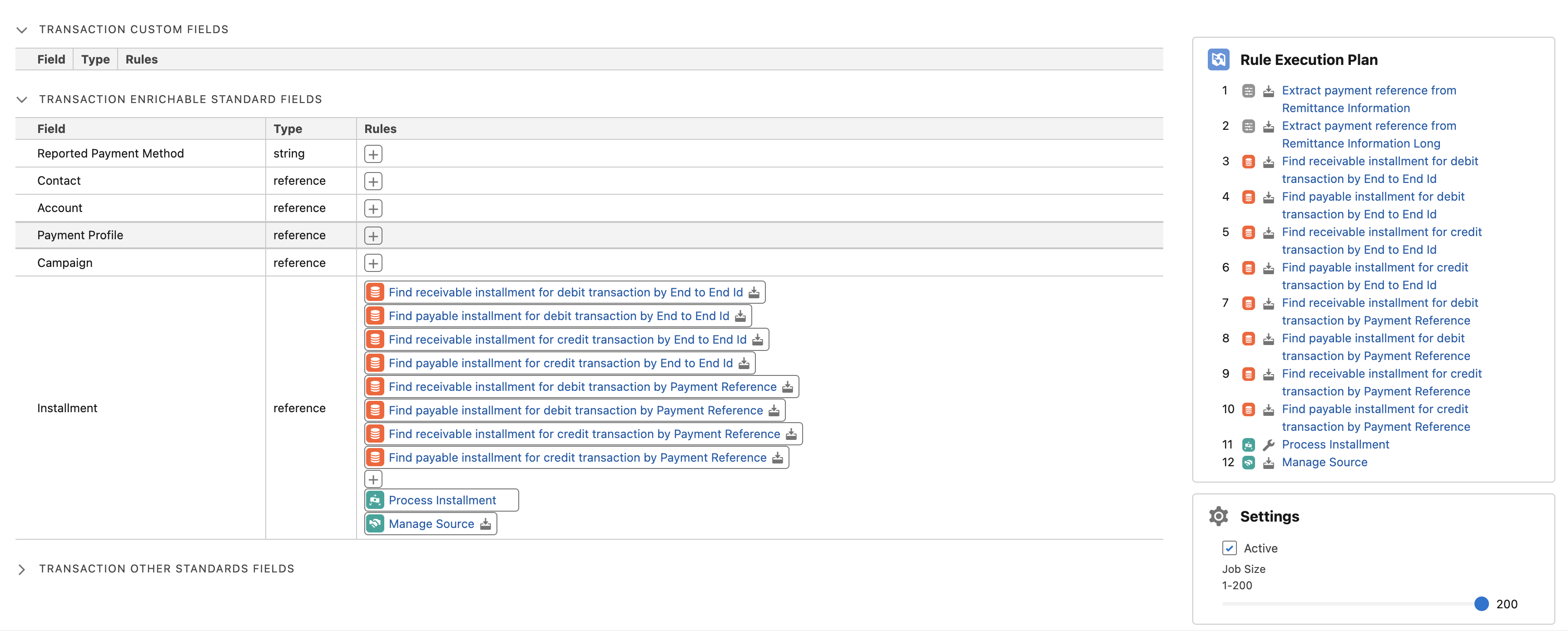
FinDock provides several managed rules out-of-the-box that will automatically process and match transactions coming in through the Bank Feed. These rules set required values for reconciliation as well as finding related installments, updating them (through the Process Installment rule), and finally updating source-specific objects as needed with the final Mange Source rule in the Rule Execution Plan.
In addition to the default managed rules, FinDock provides bank-specific rule templates through FinDock Labs. When a new bank account is connected, FinDock automatically checks the repository for templates for that bank using the first four digits of the BIC. If rule templates are found, they are added to the default Guided Matching setup for that account, alongside the managed rules already provided.
For existing bank accounts that have new templates available, the rules can be added manually through the rule selector popup where we have a new Rule Templates section.

Single, multiple and batch matching
The Process Installment rule includes the key logic for updating installments based on matched transactions. The rule handles three scenarios for Bank Feed:
- Single: one transaction matched to one installment
- Multiple: one transaction matched to multiple installments from the same payer
- Batch: one transaction is matched to multiple installments from multiple payers
The batch matching scenario is new for Bank Feed. With file-based reconciliation, batch matching is handled by ProcessingHub. Guided Matching uses the same logic, but we have introduced new features to Guided Matching components to help you with batch matching.
First, note that the Always option for Go to Guided Review in the Process Installment rule settings applies now to all three matching scenarios. Other settings are not applied to batch matching.
If FinDock identifies an incoming transaction as a batch, the Guided Matching component on the transaction set shows you the status of the batch validation and installment matching. For example, in the screenshot below, validation succeeds and all 100 identified installments were matched, leaving no remaining amount open.
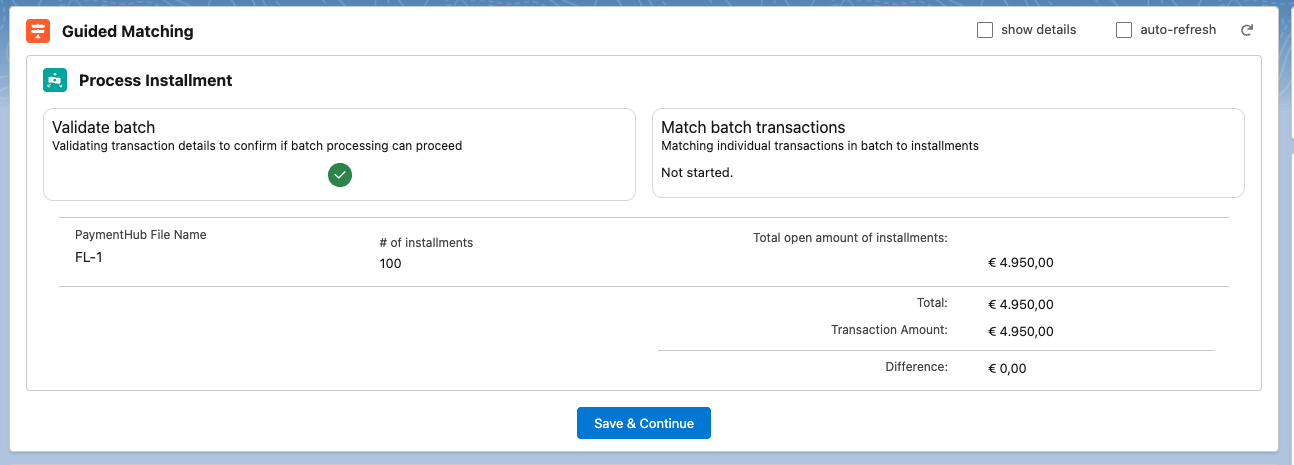
Bank Feed transaction mapping
The following table outlines how incoming data fields are mapping to fields on Transaction records.
| Incoming Field | Transaction Field |
|---|---|
| debtorName | Account Holder Name |
| transactionId | Account Servicer Reference |
| additionalInformation + additionalInformationStructured | Additional Entry Information |
| transactionAmount | Amount |
| debtorAccount > Iban/bban | Bank Account Number |
| debtorAgent/creditorAgent | BIC Code |
| transactionAmount.ccy | Currency |
| bookingDate | Date |
| endToEndId | End To End ID |
| entryReference | Entry Reference |
| mandateId | Mandate Reference |
| remittanceInformationStructuredArray | Remittance Information (if >256 characters, then Remittance Information Long) |
| remittanceInformationUnstructured | Payment Reference |
| remittanceInformationUnstructured | Remittance Information (if >256 characters, then Remittance Information Long) |
| remittanceInformationUnStructuredArray | Remittance Information (if >256 characters, then Remittance Information Long) |
| proprietaryBankTransactionCode | Reported Payment Method Code |
| valueDate | Value Date |
In addition, the following summary values are included in Transaction Set records.
| Incoming Field | Transaction Set Field |
|---|---|
| balanceAfterTransaction* | Closing Balance |
| creditAmount | Total Amount Credit |
| creditCount | Number Of Credit Entries |
| debitAmount | Total Amount Debit |
| debitCount | Number Of Debit Entries |
| N/A (calculated) | Opening Balance |
* From most recent transaction in set. If not available, FinDock uses a second endpoint to determine account balance information.
Scope and limitations
Bank Feed is enabled through our partnership with GoCardless and leverages their Bank Account Data service. While our standardized reconciliation logic supports all countries, FinDock Bank Feed supports a limited, though broad number of banks, currently around 2,500 mostly in Europe.
To see if your bank is supported, please check from the GoCardless coverage details.

